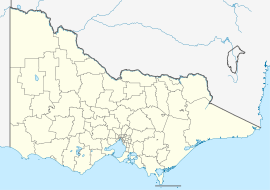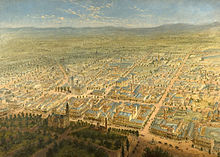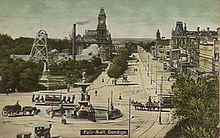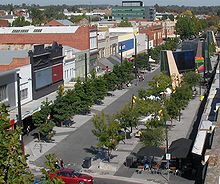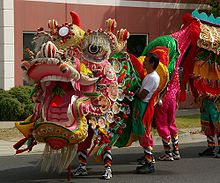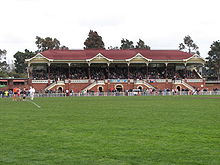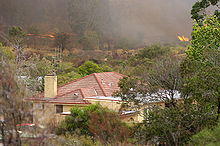- Bendigo
-
For other uses, see Bendigo (disambiguation).
Bendigo
Victoria
View of Central Bendigo and eastern suburbs from Camp HillPopulation: 91,713 (June 2010 SD)[1] (20th) Established: 1851 Postcode: 3550 Coordinates: 36°45′S 144°16′E / 36.75°S 144.267°ECoordinates: 36°45′S 144°16′E / 36.75°S 144.267°E Elevation: 225 m (738 ft) Area: 2998.97 km² (1,157.9 sq mi) Time zone: • Summer (DST)
AEST (UTC+10) AEST (UTC+11)
Location: 150 km (93 mi) NW of Melbourne LGA: City of Greater Bendigo County: Bendigo State District: Federal Division: Division of Bendigo Mean max temp Mean min temp Annual rainfall 20.7 °C
69 °F7.5 °C
46 °F550.7 mm
21.7 inBendigo (pronounced /ˈbɛndɨɡoʊ/) is a major regional city in the state of Victoria, Australia, located very close to the geographical centre of the state[2] and approximately 150 kilometres (93 mi) north west of the state capital Melbourne. It is the second largest inland city and fourth most populous city in the state. The estimated urban population is 91,713.[1][3] It is the administrative centre for the City of Greater Bendigo which encompasses both the urban area and outlying towns spanning an area of approximately 3,000 square kilometres (1,158 sq mi). Inhabitants of Bendigo are known as Bendigonians.[4]
Originally taking its name from the Bendigo Creek, the name became official in 1891. Shortly afterwards, the term "Bendigonians" was coined to describe its residents.
Bendigo is one of the most significant Victorian era boomtowns in Australia. Gold was discovered in 1851 at The Rocks on Bendigo Creek and the Bendigo Valley was found to be a rich alluvial field where gold could easily be extracted. News of the finds intensified the Victorian gold rush bringing an influx of migrants to the city from around the world within a year and transforming it from a station to a major settlement in the newly proclaimed Colony of Victoria.
Bendigo is notable for its Victorian architectural heritage and gold mining history. Since 1851 over 22 million ounces of gold have been extracted from its goldmines, making it the highest producing 19th Century goldfield in Australia in the nineteenth century and the largest gold mining economy in Eastern Australia. It is the largest finance centre in Victoria outside of Melbourne as home to Australia's only provincially headquartered retail bank, the Bendigo Bank, and the Bendigo Stock Exchange (BSX).
Contents
History
Toponomy
The current name dates to the Victorian Gold Rush as a shortened form of Bendigo Creek goldfields, simply "Bendigo Creek" or "Bendigo's Valley". The creek was named after a famous local boxer and shepherd who had earned the nickname Bendigo in reference to the Nottingham prize-fighter, William Abednego Thompson, generally known as “Bendigo Thompson”.
Its first official name was Castleton after the mining town Castleton, Derbyshire, England. Sandhurst, after Royal Military Academy Sandhurst, became the official designation for the settlement in 1854 although the nickname Bendigo remained popular.
After a plebiscite in 1891 the city was renamed to the popular Bendigo, although the name Sandhurst has a legacy and is still used by some as an alternative name for the city.
Prehistory and European discovery
Before European settlement the area was occupied by the clans of the Dja Dja Wrung people. They were regarded by other tribes as being a superior people, not only because of their rich hunting grounds but because from their area came a greenstone rock for their stone axes. Early Europeans described the Dja Dja Wrung as a strong, physically well-developed people and not belligerent. Nevertheless the early years of European settlement in the Mount Alexander area were bloodied by many clashes between intruder and dispossessed.
Major Mitchell passed through in 1836. Following his discovery, the first squatters arrived in 1840 to establish vast sheep runs. Bendigo Creek was part of the Mount Alexander or Ravenswood sheep run.
1850s: Gold rush boomtown
In the late spring of 1851 two women from the Ravenswood Run, Margaret Kennedy and Julia Farrell, struck gold in "The Rocks" area of Bendigo Creek, in what is now the suburb of Golden Square. They were seen with gold by a journalist who reported what he saw to Melbourne and the rush to Bendigo began.
Chinese people, in particular, were attracted to the Bendigo goldfields in great numbers, establishing a large Chinatown on a bountiful gold run to the north west of the city.
The Post Office opened on 1 July 1852 and was the first Victorian post office to open in a goldmining settlement.[5]
In 1853 there was a massive protest march by surface miners against the amount of the gold licence fee and the frequency with which it was collected. This protest, the Red Ribbon Agitation, was peaceful (unlike the later Eureka event in Ballarat) because of the ability of the miners' leaders and the young Scots Police Commissioner, Joseph Anderson Panton.
Numerous pit mines later exploited the underground ores which are found in elongated saddle quartz reefs in corrugated sedimentary rock.
Bendigo quickly grew from a “city of tents” to become a substantial city with great public buildings. The first hospital was built in 1853 and the first town plan was developed by 1854. A municipality emerged and the first Town Hall was commissioned in 1859.
Bendigo was connected to Melbourne by telegraph in 1857 and it was from here that the first message reporting the deaths of Burke and Wills was sent in 1861. The Bendigo Benevolent Asylum, now known as the Anne Caudle Centre, was erected in 1860. Frequent Cobb & Co coaches ran to Melbourne until the railway reached Bendigo in 1862.
1870s: A city develops
In the following decade it made the transition from small mining town to large and wealthy city, and becoming established as a key centre for surrounding settlements.
Water supply was always a problem in Bendigo. This was partly solved with a system harnessing the waters of the Coliban River, designed by engineer Joseph Brady. Water first flowed through the viaduct in 1877.
Bendigo from its earliest days has been one of the major Cornish Australian settlement areas. In 1881 46.9 percent of fathers and 41.4 percent of mothers in Bendigo were born in Cornwall[citation needed]. This was in addition to those Cornish who were born in Australia or places as far afield as Mexico or Brazil. The Cornish in Bendigo outnumbered the combined strength of their Irish and Scottish counterparts.[6]
Architect William Charles Vahland left a major mark on Bendigo during this period. He is credited as innovating what was the most popular residential design of the period, low cost cottages with verandahs decorated in iron lace which became a popular style right across Victoria. He transformed the Bendigo Town Hall between 1878 to 1886 into a grand building and designed more than eighty more public and private buildings, including the Alexandra Fountain, the Masonic Temple (now the Capital Theatre[7] ) and the Mechanics Institute and School of Mines (now the Bendigo Regional Institute of TAFE), 'Fortuna Villa' in Golden Square, (which was the home of 'Quartz King' George Lansell), the Law Courts, former Post Office and the expanded Shamrock Hotel in Pall Mall.
A tram network began in 1890 and was used for public transport.
20th century
As gold mining operations were reduced, Bendigo from the 1930s consolidated as a manufacturing and regional service centre and continued to grow steadily.
Urban structure
The central area (CBD) of Bendigo consists of approximately 20 blocks of mixed use area. The main street is the Calder Highway, the section running through the CBD is also known "Pall Mall" while the main shopping area is centred around Hargreaves Mall.
Suburbs
Bendigo is a major regional city and has expanded with several suburbs some of which (such as Eaglehawk) were once independent satellite townships and many which extend into the surrounding bushland. Bendigo's suburbs include: Ascot; Big Hill; California Gully; Eaglehawk; Eaglehawk North; Epsom; Flora Hill; Golden Square; Ironbark; Kangaroo Flat; Kennington; Maiden Gully; North Bendigo; Quarry Hill; Sailors Gully, Spring Gully; Strathdale; Strathfieldsaye; West Bendigo and White Hills.
Architectural heritage
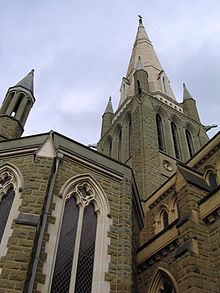 Sacred Heart Cathedral is Bendigo's tallest building and a major landmark of the CBD
Sacred Heart Cathedral is Bendigo's tallest building and a major landmark of the CBD
As a legacy of the gold boom Bendigo has many magnificent ornate buildings built in a late Victorian colonial style. Many buildings are on the Victorian Heritage Register and registered by the National Trust of Australia. Prominent buildings include the Bendigo Town Hall (1859, 1883–85), Post Office, Law Courts (1892–96), Shamrock Hotel (1897), Institute of Technology and Memorial Military Museum (1921) all in the Second Empire-style.
Architect Vahland, encouraged European artisans to emigrate to the Sandhurst gold fields and so create the Vienna(Wien) of the south.[citation needed]
Bendigo's Sacred Heart Cathedral, a large sandstone church, is the third largest cathedral in Australia and one of the largest cathedrals in the Southern Hemisphere. The main building was completed between 1896–1908 and the soaring spire between 1954 and 1977.
Fortuna Villa is a large surviving Victorian mansion, built for Christopher Ballerstedt and later owned by George Lansell.
Many other examples of Bendigo's classical architecture rank amongst the finest classical commercial buildings in Australia and include the Colonial Bank building (1887) and the former Masonic Hall (1873–74) which is now a performing arts centre.
Bendigo's Joss house, a historic temple, was built in the 1860s by Chinese miners and is the only surviving building of its kind in regional Victoria which continues to be used as a place of worship.
The historic Bendigo Tram Sheds and Power Station (1903) now house Bendigo's tramway museum.
The Queen Elizabeth Oval still retains its ornate 1901 grandstand.
Parks and gardens
The central city is skirted by Rosalind Park, a Victorian style garden featuring statuary and a large blue stone viaduct. The main entrance corner of the park is on the intersection known as the Charing Cross, formerly the intersection of two main tram lines (now only one). It features a large statue of Queen Victoria.
The Charing Cross road junction features the large ornate Alexandra fountain (1881) and is built on top of a wide bridge which spans the viaduct. The park elevates toward Camp Hill, which features a historic school and former mine poppet head.
Further from the city is Lake Weroona, a large ornamental lake, adjacent to the Bendigo Botanical Gardens first opened in 1869.
Demographics
Bendigo
population by year[8][9][10]1891 34,089 1901 39,141 1911 36,127 1921 30,401 1933 29,131 1947 30,779 1954 36,918 1961 40,335 1966 42,208 1971 45,936 1976 55,152 1981 58,818 1986 65,134 1991 72,083 1996 74,192 2001 79,673 2006 84,883 2009 89,995* - From preliminary ABS estimate
Economy
Bendigo is a large and growing service economy. The major industries are tourism, commerce, education and primary industries.
Bendigo's growth is largely at the expense of small surrounding rural towns (such as Elmore, Rochester, Inglewood, Dunolly and Bridgewater) which in contrast are in steep decline[citation needed].
Tourism
Tourism is a major component of the Bendigo economy, generating over A$364 million in 2008/09.[11] Bendigo is popular with heritage tourists and cultural tourists with the focus of tourism on the city's gold rush history. Prominent attractions include the Central Deborah Gold Mine, Golden Dragon Museum and the Bendigo Tramways (all three of which are managed by The Bendigo Trust, a council-intertwined organisation dedicated to preserving Bendigo's heritage).
Commerce
The main retail centre of Bendigo is the central business district, with the suburbs of Eaglehawk, Kangaroo Flat, Golden Square, Strathdale and Epsom also having shopping districts.
The city is home to Australia's only provincial stock exchange, the Bendigo Stock Exchange (BSX), founded in the 1860s.
The city is the home of the headquarters of Bendigo Bank; established in 1858 as a building society it is now a large retail bank with community bank branches throughout Australia. The bank is headquartered in Bendigo, and is a major employer in the city (it also has a regional office at Melbourne Docklands).
The call centre of Telecommunications provider AAPT is based here,[12] as is the home of Bendigo Community Telco (founding subsidiary of Community Telco Australia).
Manufacturing
The 2005 Bendigo Council Annual Report indicated about 13% of the workforce are employed in manufacturing[citation needed]. After the Victorian gold rush the introduction of deep quartz mining in Bendigo caused the development of a heavy manufacturing industry. Little of that now remains but there is a large foundry which makes train and vehicle parts and there is also a rubber factory. The Thales Australia (formerly ADI Limited) is an important heavy engineering company. Australia Defence Apparel is another key defence industry participant making military and police uniforms and bulletproof vests. Intervet (formerly Ausvac) is an important biotechnology company, producing vaccines for animals.
Education
Bendigo Senior Secondary College is the largest VCE (Victorian Certificate of Education) provider in the State. Bendigo Regional Institute of TAFE. Catholic College Bendigo follows close after, which ranges from years 7–9 at the La Valla campus and 10–12 at the Coolock campus. Girton Grammar School is Bendigo's only private school. The Bendigo campus of La Trobe University is also a large and growing educational institution.
Farming and agriculture
The surrounding area, or "gold country", is quite harsh rocky land with scrubby regrowth vegetation. This Box-Ironbark forest is used for timber (mainly sleepers and firewood) and beekeeping.
Sheep and cattle are grazed in the cleared areas. There are some large poultry and pig farms. Some relatively fertile areas are present along the rivers and creeks, where wheat and other crops such as canola are grown. The area produces premium wines, including shiraz, from a growing viticulture industry. Salinity is a problem in many valleys, but is under control. There is a relatively small eucalyptus oil industry.
Bendigo provides services (including a large livestock exchange) to a large agricultural and grazing area on the Murray plains to its north.
Gold mining
One of the major revolutions in gold mining (during the Victorian gold rush) came when fields like Bendigo but also Ballarat, Ararat, and the gold fields close to Mount Alexander turned out to have large gold deposits below the superficial alluvial deposits that had been (partially) mined out. Gold at Bendigo was found in quartz reef systems, hosted within highly deformed mudstones and sandstones or were washed away into channels of ancient rivers. Tunnels as deep as 2000 or even 3000 feet (600 to 900 metres) (Stawell) were possible.[13]
Until overtaken in the 1880s by the Western Australia goldfields, Bendigo was the most productive Australian gold area, with a total production of over 20 million ounces (622 t). There is a large amount of gold still in the Bendigo goldfields, estimated to be at least as much again as what has been removed. The decline in mining was partly due to the depth of mines and the presence of water in the deep mines. With modern technology, Bendigo Mining NL has resumed mining and is currently winning gold at approximately 40,000 ounces (1 tonne) a year.
Infrastructure
Transport
Bendigo is connected via the Calder Freeway to Melbourne, which is less than two hours by car[citation needed]. The remaining section of highway nearest Bendigo was recently upgraded to dual carriageway standard ensuring that motorists can travel up to speeds of 110 km/h for most of the journey. Many other regional centres are also connected to Melbourne via Bendigo, making it a gateway city in the transport of produce and materials from northern Victoria and the Murray to the Port of Melbourne and beyond.
Bendigo act as a major rail hub for northern Victoria, being at the junction of several lines including the Bendigo railway line which runs south to Melbourne and lines running north including the Swan Hill railway line, Echuca railway line and Eaglehawk–Inglewood railway line. V/Line operates regular VLocity passenger rail services to Melbourne's Southern Cross Station with the shortest peak journeys taking approximately 91 minutes from Bendigo railway station, generally however services take 2 hours or longer. While there are several rail stations in the urban area, only two other stations currently operated for passengers: Kangaroo Flat railway station on the Bendigo Line and Eaglehawk railway station, the later being the terminus for some services from Melbourne. There are also additional train services to and from Swan Hill, and Echuca. The Regional Rail Link promises more reliable services between Bendigo and Melbourne by providing some separation from the Melbourne metropolitan rail network.
Bendigo is also served by an extensive bus network which radiates mostly from the CBD towards the suburbs. The city is also serviced by several expansive taxi services.
Trams in Bendigo have historically operated an extensive network a form of public transport, however the remains of the network was reduced to a tourist service in 1972.[14] Short trials of commuter tram services was held in 2008 and 2009 with little ridership.[15]
Bendigo is served by Bendigo Airport, which is located to the north of the city on the Midland Highway. The Bendigo Airport Strategic Plan was approved in 2010 for proposed infrastructure upgrades including runway extension and buildings to facilitate larger planes and the possibility of regular passenger services from major cities in other states.[16]
Health
Bendigo Base Hospital is the city's largest hospital, only public hospital and a major regional hospital. St John of God is the largest private hospital.
Utilities
Bendigo is entitled to a portion of the water in Lake Eppalock, an irrigation reservoir on the Campaspe River. Recent developments have led to the building of a pipeline from Waranga to Lake Eppalock and thence to Bendigo in 2007. There is a dam (and a road) called Faugh A Ballagh.
Culture and events
The Bendigo Art Gallery is one of Australia’s oldest and largest regional art galleries.
The Capital Theatre is located next to the art gallery in View Street and hosts performing arts and live music.
The city hosts the Bendigo National Swap Meet for cars every year in early November. It is regarded[by whom?] as the biggest in the southern hemisphere and attracts people from all over Australia and the world.
The city hosts the Victorian leg of the annual Groovin' the Moo music festival. It is held at the Bendigo Showgrounds and is usually held in late April or early May. The festival regularly sells out and brings many big Australian and international acts to the city. It also attracts thousands of people from around Victoria to the city for the weekend.
The Bendigo Easter Festival is held each year and attracts tens of thousands of tourists to the city over the Easter long weekend. Attractions include parades, exhibitions and a street carnival.
Media
Bendigo is served by three newspapers; The Advertiser, The Bendigo Miner and the Bendigo Weekly. There are also six locally based radio stations; (EasyMix Ten71am and 98.3FM) Star FM, 3BO FM and ABC Local Radio as well two national radio stations Triple J and ABC Radio National and the community stations Phoenix FM (Central Victoria), 101.5 Bendigo's Best Sport and KLFM.
There are five television stations; WIN, Prime, Southern Cross Ten, ABC and SBS. Local programming consists of 30-minute weeknight news bulletins on WIN and short news updates on Southern Cross Ten. Prime also maintains a sales office in the region. All five networks also transmit new additional digital television channels.
On 5 May 2011, analogue television transmissions ceased in most areas of regional Victoria and some border regions including Bendigo and surrounding areas. All local free-to-air television services are now being broadcast in digital transmission only. This was done as part of the Federal Government`s plan for Digital terrestrial television in Australia, where all analogue television transmission is being gradually switched off and replaced with DVB-T transmission.
Music
There are several live music venues with local independent bands and artists performing on a regular basis. There also several adult choirs and the Bendigo Youth Choir which often performs overseas, the Bendigo Symphony Orchestra, the Bendigo Symphonic Band, several brass bands and three pipe bands.[17] Musicians originally from Bendigo include Patrick Savage – film composer[18] and former principal first violin of the Royal Philharmonic Orchestra in London,[19] James Dennis (Jimmy J.R), Rick Moyle and Mark Pecos of the JR Baker Band. Australian Idol winner Kate DeAraugo grew up in Bendigo where her family still live.
Sports
Cricket and Australian rules football are the most popular sports in Bendigo. The Queen Elizabeth Oval (referred to locally as the "QEO") hosts both sports. The Bendigo Bombers are a semi-professional Australian Rules team that competes in the Victorian Football League. The Bendigo region is also home to the historic Bendigo Football League, a strong local Australian rules football competition. The Bendigo Cup is a famous horse racing event. The Bendigo and District Cricket Association is the controlling body for ten senior cricket clubs within the Bendigo area. The Emu Valley Cricket Association organises matches for thirteen club around the Bendigo district, from Marong in the north to Heathcote is the south. The Bendigo Madison is a large prestigious cycling event, attracting international calibre cyclists.
Bendigo hosts the richest professional running 400m in the world called the Black Opal. It is held in March each year and usually sees thousands of people at the venue with professional running races as well as cycling events (featuring the Bendigo Madison) over a two-day carnival. The 400 m Black Opal and 120 m Bendigo Gift finals are conducted before the Bendigo Madison on the second night (Sunday) of the carnival.
Tennis is popular in Bendigo with the Bendigo Tennis Association (BTA) hosting local and national tournaments at its many court locations throughout the city. The Bendigo Indoor Sports & Leisure Centre (BISLC) (five synthetic hard courts) in Strathdale is the only indoor tennis complex in the region, and the huge 30 synthetic hard court Coca-Cola Tennis Complex next to Lake Weeroona being one of the largest in the southern hemisphere. The Bendigo Lawn Tennis Club also has 16 natural grass courts, one of the largest in the region.
Swimming is a popular, year-round sport in Bendigo. There are four competitive clubs those being the Eaglehawk Swimming Club, Bendigo East Swimming Club, Bendigo Swimming Club and the Kangaroo Flat Swimming Club. The home of the Eaglehawk Swimming Club is located at the Peter Krenz Leisure Centre in Eaglehawk in the city's north-west. Among many other fitness and leisure facilities the centre boasts Central Victoria's only 50m, heated indoor swimming pool. The pool provides for year-round training and competition for swimmers of all ages across the City of Greater Bendigo. Competition-class 50m pools can also be found at the Bendigo Aquatic Centre in the centre of Bendigo and at Bendigo East.
Basketball is popular in Bendigo, the city is home to the Schweppes Centre, home of the Bendigo Braves. The stadiums hosted basketball during the 2006 Commonwealth Games. The city is also home to the Bendigo Basketball Association. Bendigo also has a team in the WNBL, the premier national female basketball competition, The Bendigo Spirit.
Bendigo was the host to the second Commonwealth Youth Games, held from 30 November to 3 December 2004.
Football (soccer) Bendigo Amateur Soccer League [2] organises and manages soccer for over 3000 juniors and seniors in Central Victoria. Bendigo is also home to the largest junior soccer club in Victoria, Strathdale Soccer Club. Bendigo along with Swan Hill, Echuca and Mildura have a team in Football Federation Victoria's Summer league. The team is the Loddon Mallee F.C.
Rugby Union – The Bendigo Fighting Miners are the only team in Bendigo, it completes in the Victorian Country Rugby Union Competition and has won the premiership for the last four years in a row.
Hockey – The CVHA Blazers represent Bendigo at State level in both male and female competitions. Bendigo Raiders Ice Hockey Team competes at both junior and senior levels within the Victorian ice hockey Association and is the only team to play that is located outside Melbourne.
There was formerly an ice rink in Bendigo, one of only two running in Victoria, but it was closed in 2010 and is unlikely to re-open.
Ice Skating – Bendigo also has an ice skating club, the Ice Skating Club of Bendigo which was instrumental in organising Regional and State skating competitions. The closure of the ice rink has limited its activities.[3]
Baseball – There are five running clubs in the Bendigo area: Eaglehawk Falcons, Bendigo East, Maiden Gully Scots, Bendigo BLS Bushrangers and Strathfieldsaye Dodgers. All of these clubs have been struggling for players for the past 5 years in both senior and junior sides. There has been two inclusions into the Bendigo Baseball Association this year with the Colts and the Rich River Rebels ebtering due to the GVBA folding. Bendigo participates in the annual VPBL state championships held across the state. This year Bendigo has won the U/18 event held in Wangaratta, and the U/12s came second in Mildura.
Orienteering – The Bendigo Orienteers Inc have hosted a variety of international carnivals including the 1985 World Orienteering Championships (4–6 September 1985) and World Masters Games orienteering events in 2002. Bendigo has also hosted several Australian Orienteering Championships including those to be held in September 2009.
Volleyball – Bendigo has a very strong volleyball association, with 5 senior divisions, 5 junior divisions and three Spikezone (primary) divisions. Competition is played Thursday nights at the Bendigo Schweppes Centre and Sunday evenings (Spikezone.) The men's Bendigo team are the current Victorian Country Champions. A number of players have represented Australia including Caitlin Thwaites and Erin Ross in the Women's Team. Juniors to have represented Australia in during 2007–8 include Jason Hughes, James Winzar, Rhiannon Judd and Karley Hynes. Bendigo's Girton Grammar School is currently the third ranked volleyball school in Australia. In 2007 the Bendigo Volleyball Association was awarded the Event of the Year for 2006-7 by the AVL for its hosting of the Australia v Argentina Volleyball Test.
Lacrosse – The Bendigo Lacrosse Club is Australia's newest lacrosse club, having been officially formed in 2008.[20] The Club is based at the Latrobe University Bendigo Athletics Track. In 2010, the club participated in the Lacrosse Victoria competition for the first time, in the Division 3 (fourth grade) senior level. The club is also looking to establish a local junior competition and encourages anyone interested in lacrosse to get involved. It is the first time in over 40 years that a lacrosse club has been active in regional Australia.
Snooker – As of 2011, Bendigo has played host to a ranking World Snooker Tour event – The Australian Goldfields Open. The 2011 tournament took place between 18 and 24 July, and was won by Stuart Bingham.[21][22]
Roller Derby – Dragon City Derby Dolls is the name of the Roller Derby League in Bendigo. The team goes by the name of The Chicko Rollers, named after the Chicko Roll, which was invented in Bendigo. Whilst the league is still in its formative stages, they compete in 'scrimmage' bouts against teams from neighbouring leagues, such as the Dayslesford Derby Dolls and Ballarat Roller Derby League. DCDD will play in their first 'official' bout against Ballarat on 12 March 2011.
Bendigo has a horse racing club, the Bendigo Jockey Club, which schedules around 22 race meetings a year at its White Hills track, including the Bendigo Cup meeting in mid-November.[23] Elmore Racing Club also hold their only meeting here in March.[24]
Bendigo Harness Racing Club conducts regular meetings at its racetrack in the city at Lords Raceway on the McIvor Highway, Junortoun.[25]
The Bendigo Greyhound Racing Club holds regular meetings at the same location.[26]
Golfers play at the course of the Bendigo Golf Club on Golf Course Road in the suburb of Epsom[27] or at the course of the Quarry Hill Golf Club on Houston Street.[28]
Environment
The city is surrounded by components of the Greater Bendigo National Park, as well as the Bendigo Box-Ironbark Region Important Bird Area, identified as such by BirdLife International because of its importance for Swift Parrots and other woodland birds.[29]
Climate
Bendigo experiences an oceanic climate (Köppen climate classification Cfb)[citation needed], typically dry and mild with cold winters. The mean minimum temperature in January is 14.3 °C (57.7 °F) and the maximum 28.7 °C (83.7 °F), although temperatures above 35 °C (95 °F) are commonly reached. The highest temperature officially recorded was 45.4 °C (113.7 °F), during the early 2009 southeastern Australia heat wave.[30] There is also a disputed recording of 47.4 °C (117.3 °F) (on 14 January 1862.[31] The mean minimum temperature in July is 3.5 °C (38.3 °F), and winter minima of below 0 °C (32 °F) have been recorded frequently. Mean maximum winter temperatures in July are 12.1 °C (53.8 °F). Most of the city's annual rainfall of 582.1 millimetres (22.92 in) falls between April and October. Snowfalls are virtually unknown, however frosts can be a common occurrence during the winter months.
Climate data for Bendigo Airport (YBDG) since 1991 Month Jan Feb Mar Apr May Jun Jul Aug Sep Oct Nov Dec Year Record high °C (°F) 43.6
(110.5)45.4
(113.7)38.6
(101.5)33.7
(92.7)26.3
(79.3)20.7
(69.3)19.7
(67.5)24.2
(75.6)30.4
(86.7)35.5
(95.9)40.3
(104.5)43.1
(109.6)45.4
(113.7)Average high °C (°F) 29.5
(85.1)29.4
(84.9)26.0
(78.8)21.2
(70.2)16.6
(61.9)13.3
(55.9)12.5
(54.5)14.3
(57.7)16.8
(62.2)20.3
(68.5)24.3
(75.7)26.9
(80.4)20.9 Average low °C (°F) 13.9
(57.0)14.1
(57.4)11.3
(52.3)7.4
(45.3)5.2
(41.4)3.6
(38.5)2.4
(36.3)2.5
(36.5)4.3
(39.7)6.3
(43.3)9.5
(49.1)11.5
(52.7)7.7 Record low °C (°F) 3.3
(37.9)4.0
(39.2)2.3
(36.1)−1.3
(29.7)−4.6
(23.7)−5.3
(22.5)−5.1
(22.8)−5
(23.0)−5.5
(22.1)−3.5
(25.7)−0.2
(31.6)1.9
(35.4)−5.5
(22.1)Precipitation mm (inches) 30.5
(1.201)26.3
(1.035)21.5
(0.846)25.8
(1.016)47.1
(1.854)50.6
(1.992)51.7
(2.035)46.2
(1.819)48.5
(1.909)39.1
(1.539)45.3
(1.783)41.8
(1.646)474.6
(18.685)Source: [32] Extreme weather events
A series of great floods occurred in Bendigo in 1859.[33][34] Substantial flooding also occurred in 1903.[35]
Tornadoes have been seen around the area of Bendigo and, although rare, the 2003 Bendigo tornado passed through Eaglehawk and other parts of the city causing major damage to homes and businesses.[36]
Bendigo was in severe drought from 2006 to 2010 and during this time the city had some of the harshest water restrictions in Australia, with no watering outside the household. Heavy rains through the winter and spring of 2010 filled most reservoirs to capacity and only wasteful water use (e.g. hosing down footpaths) is currently banned.[37]
Bendigo was affected by the Black Saturday bushfires in 2009. A fire to the west of the city burned out 500 hectares (1,200 acres).[38] The fire broke out at about 4.30 pm on the afternoon of 7 February, and burned through Long Gully and Eaglehawk, coming within 2 kilometres (1.2 mi) of central Bendigo, before it was brought under control late on 8 February.[38] It destroyed approximately 58 houses in Bendigo's western suburbs, and damaged an electricity transmission line, resulting in blackouts to substantial parts of the city.[39] There was one fatality from the fire.
Flash floods occurred across Bendigo during 2010. The first in March[40] and the most severe at the beginning of September.[41]
Sister cities
Notable residents
Politics
- John Bannon, Labor Premier of South Australia, 1982–1992
- Frank Brennan, Federal Attorney-General, 1929–31
- Tom Brennan, older brother of Frank and Federal UAP Senator, 1931–37
- John Brumby, Labor Premier of Victoria, 2007–2010
- John Gunn, Labor Premier of South Australia, 1924–26
- Edward Heitmann, Federal Labor politician, 1917–1919
- John Lutey, Labor Party member of the West Australian parliament, 1917–1932
- Peter Ryan, current leader of the Victorian National Party
Sport
- AFL players – Graham Arthur, Nathan Brown, Wayne Campbell, Nick Dal Santo, Eric Fleming, Trevor Keogh, Barry Mulcair, Troy Selwood, Adam Selwood, Joel Selwood, Scott Selwood, Geoff Southby, Colin Sylvia, Brian Walsh, Greg Williams
- Don Blackie, Test cricketer
- Kristi Harrower, national basketballer
- Stephen Huss, 2005 Wimbledon men's doubles champion
- Faith Leech, Olympic swimming champion
- Billy Murdoch, Australian Test cricket captain
- Ricky Nixon, sports agent and former AFL footballer
- Lisle Nagel, Australian Test cricketer
- Glen Saville, Australian and NBL basketballer
- Ben Hunt, NCAA, NBA, and NBL basketballer
- Craig White, English cricket player
- Sharelle McMahon, Australian Netball Team captain, Melbourne Vixens captain
Arts
- Bunney Brooke, TV actress
- Kate DeAraugo, 2005 Australian Idol winner
- Colleen Hewett, singer and actress
- Keith Lamb, lead singer of Hush
- Ernest Moffitt, artist
- William Moore, art and drama critic
- William David Murdoch, concert pianist
- John Bernard O'Hara, poet and schoolmaster
- Alfred Henry O'Keeffe, artist
- Ian Rilen, bass guitarist with Rose Tattoo
Science
- John Irvine Hunter, professor of anatomy
- Struan Sutherland, antivenin researcher
- Geoffrey Watson, professor of statistics
- Frank Milne, professor of economics
Business
- Frank McEncroe, inventor of the Chiko Roll
- Sidney Myer, philanthropist and founder of the Myer chain of department stores, Australia's largest retailer
Religion
- Sydney James Kirkby, Anglican bishop
Military
- Carl Jess, Australian Army Lieutenant General
- John Campbell Ross, last Australian World War I veteran
- Sir Gilbert Dyett, long-serving President of the Returned and Services League of Australia
See also
- List of Mayors of Bendigo
- Bendigo Easter Festival
- HM Prison Bendigo
- Bendigo Senior Secondary College
- Flora Hill Secondary College
- Golden Square Secondary College
- Catholic College Bendigo
- 2003 Bendigo tornado
References
- Notes
- ^ a b 3218.0 – Regional Population Growth, Australia, 2009–10. Abs.gov.au. Retrieved on 18 August 2011.
- ^ http://www.bendigo.vic.gov.au/page/page.asp?page_Id=1711&h=0
- ^ "3218.0 – Regional Population Growth, Australia, 2008–09". Australian Bureau of Statistics. 30 March 2010. http://www.abs.gov.au/AUSSTATS/abs@.nsf/DetailsPage/3218.02008-09?OpenDocument.
- ^ Search results for "Bendigonian" – Bendigo Weekly Online Edition
- ^ Premier Postal History. "Post Office List". https://www.premierpostal.com/cgi-bin/wsProd.sh/Viewpocdwrapper.p?SortBy=VIC&country=. Retrieved 11 April 2008
- ^ Payton, Philip, Making Moonta: The Invention of Australia's Little Cornwall
- ^ [1]
- ^ I. McCalman, A. Cook, A. Reeves (2001). Gold: Forgotten Histories and Lost Objects of Australia. Retrieved 22 November 2009.
- ^ 3105.0.65.001 – Australian Historical Population Statistics, 2006. Abs.gov.au. Retrieved on 18 August 2011.
- ^ Census 2006 AUS|id=2030|name=Bendigo (VIC) (Statistical District)|accessdate=27 September 2007}}
- ^ http://121.50.208.46/bendigo/BTB%20AnnRep%20FINAL.pdf
- ^ Bendigo Bank builds community model with AAPT venture. Theage.com.au. Retrieved on 18 August 2011.
- ^ AMJ Ferguson. Gold, Gems and Pearls in Ceylon and Southern India. London, John Haddon & Co.. pp. 283 URL: Gold, Gems, Pearls Ceylon, Australian Gold Fields Discussion
- ^ "The Bendigo Trust". www.bendigotrust.com.au. Archived from the original on 17 June 2008. http://web.archive.org/web/20080617055859/http://www.bendigotrust.com.au/bendigotramways.html. Retrieved 7 June 2008.
- ^ "Tram trial gets mixed results". Tram Talk. Friends of the Bendigo Tramways. Autumn Issue, 2009. http://www.bendigotramways.com/20_friends/2009_tramtalk_autumn.pdf. Retrieved 7 July 2010.
- ^ http://www.bendigo.vic.gov.au/Files/Bendigo_Airport_Strategic_Plan_adopted_3_June_2009.pdf
- ^ "Arts Register". City of Greater Bendigo. 2010. http://www.bendigo.vic.gov.au/Directory/s2.asp?S1Key=5&S2key=36&S3Key=212&Show=y&h=0. Retrieved 6 June 2010.
- ^ http://www.imdb.com/name/nm2747682/
- ^ Woman, The. (26 August 2010) Sample a Bit of the Score from Fetch | Horror Movie, DVD, & Book Reviews, News, Interviews at Dread Central. Dreadcentral.com. Retrieved on 18 August 2011.
- ^ Bendigo Lacrosse Club. Bendigolacrosse.com. Retrieved on 18 August 2011.
- ^ Article on BBC Sport Website. BBC News (23 May 2011). Retrieved on 18 August 2011.
- ^ Article on BBC Sport Website. BBC News (24 July 2011). Retrieved on 18 August 2011.
- ^ Country Racing Victoria. "Bendigo Jockey Club". http://www.countryracing.com.au/index.php?option=com_club_info&club=47&Itemid=80. Retrieved 7 May 2009[dead link]
- ^ Country Racing Victoria. "Elmore Racing Club". http://www.countryracing.com.au/index.php?option=com_club_info&club=115&Itemid=80. Retrieved 7 May 2009[dead link]
- ^ Australian Harness Racing. "Bendigo". http://www.harness.org.au/bendigo/bendigo.cfm?fromstate=vic. Retrieved 11 May 2009
- ^ Greyhound Racing Victoria. "Bendigo". http://bendigo.grv.org.au/index.html. Retrieved 15 April 2009[dead link]
- ^ Golf Select. "Bendigo". http://www.golfselect.com.au/armchair/courseView.aspx?course_id=261. Retrieved 11 May 2009
- ^ Golf Select. "Quarry Hill". http://www.golfselect.com.au/armchair/courseView.aspx?course_id=1070. Retrieved 11 May 2009
- ^ "IBA: Bendigo Box-Ironbark Region". Birdata. Birds Australia. http://www.birdata.com.au/iba.vm. Retrieved 2011-10-23.
- ^ "The exceptional January–February 2009 heatwave in south-eastern Australia", Bureau of Meteorology (National Climate Centre): p. 2, 12 February 2009, http://www.bom.gov.au/climate/current/statements/scs17d.pdf
- ^ Aikman, Rod (8 February 2003). "Weather history preserved". The Advertiser. http://www.bendigoadvertiser.com.au/news/local/news/opinion/weather-history-preserved/722078.aspx. Retrieved 5 August 2011.
- ^ "Climate statistics for Bendigo". Bureau of Meteorology. July 2011. http://www.bom.gov.au/climate/averages/tables/cw_081123_All.shtml. Retrieved 28 December 2009.
- ^ The Argus (Melbourne, Vic. : 1848–1954) Monday 30 May 1859, page 6
- ^ The Courier (Hobart, Tas. : 1840–1859) Friday 20 May 1859, page 2
- ^ The Argus (Melbourne, Vic. : 1848–1954) Tuesday 29 December 1903, page 6
- ^ "'Mini tornado' wreaks havoc – theage.com.au". Melbourne: www.theage.com.au. 19 May 2003. http://www.theage.com.au/articles/2003/05/18/1053196481064.html. Retrieved 30 March 2008.
- ^ Coliban Water – Permanent Water Saving Rules. Coliban.com.au. Retrieved on 18 August 2011.
- ^ a b "Meeting held for fire-affected Bendigo residents". Australian Broadcasting Corporation. 9 February 2009. http://www.abc.net.au/news/stories/2009/02/08/2485623.htm. Retrieved 9 February 2009.
- ^ Power, Emily; Collier, Karen (9 February 2009). "The man up the road is on fire". Herald Sun (Australia). http://www.news.com.au/heraldsun/story/0,21985,25025484-2862,00.html. Retrieved 9 February 2009.
- ^ Bendigo flood clean-up, then the cost – Local News – News – General – The Advertiser. Bendigoadvertiser.com.au (8 March 2010). Retrieved on 18 August 2011.
- ^ Deluge causes flood havoc across central Victoria – Local News – News – General – The Advertiser. Bendigoadvertiser.com.au (5 September 2010). Retrieved on 18 August 2011.
- ^ "Sister Cities". City of Greater Bendigo. http://www.bendigo.vic.gov.au/Page/page.asp?Page_Id=232&h=1. Retrieved 1 November 2010.
External links
 Media related to Bendigo at Wikimedia Commons
Media related to Bendigo at Wikimedia Commons- Bendigo Visitor Information and Interpretive Centre
- Bendigo Tramways
- Coliban Water, including an illustrated history of the water channel from the Coliban River
- City of Greater Bendigo: Bendigo's Heritage
- City of Greater Bendigo Annual Report 2005
- Victorian Heritage Register (1999), Heritage Victoria
- Bendigo community
Suburbs and Towns in the City of Greater Bendigo Local Government Area Suburbs: Ascot · Bendigo · California Gully · Eaglehawk · Eaglehawk North · East Bendigo · Epsom · Flora Hill · Golden Gully · Golden Square · Ironbark · Jackass Flat · Junortoun · Kangaroo Flat · Kennington · Long Gully · Maiden Gully · North Bendigo · Quarry Hill · Sailors Gully · Spring Gully · Strathdale · Strathfieldsaye · West Bendigo · White Hills
Outlying Towns: Argyle · Avonmore · Axe Creek · Axedale · Bagshot · Bagshot North · Barnerdown · Big Hill · Costerfield · Derrinal · Drummartin · Elmore · Emu Creek · Eppalock · Fosterville · Goornong · Harcourt · Heathcote · Hunter · Huntly · Huntly North · Junortoun · Kamarooka · Kimbolton · Knowsley · Ladys Pass · Leikhart · Lockwood · Lockwood South · Longlea · Lyal · Mandurang · Mandurang South · Marong · Mia Mia · Mount Camel · Myrtle Creek · Myers Flat · Neilborough · Ravenswood · Raywood · Redcastle · Redesdale · Sedgwick · Sebastian · Shelbourne · Tooleen · Wellsford · Whipstick · Wilsons Hill · Woodvale
Cities of Victoria, Australia Regional VictoriaArarat · Bairnsdale · Ballarat · Benalla · Bendigo · Castlemaine · Colac · Echuca · Geelong · Hamilton · Horsham · Maryborough · Mildura · Moe · Morwell · Portland · Sale · Shepparton · Swan Hill · Traralgon · Wangaratta · Warrnambool · WodongaCategories:- Cities in Victoria (Australia)
- Wine regions of Victoria (Australia)
- Bendigo
Wikimedia Foundation. 2010.

